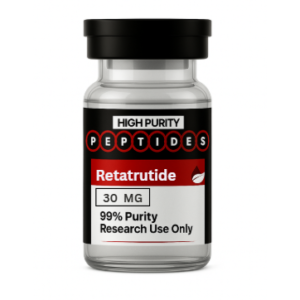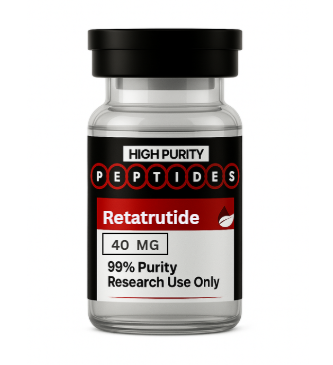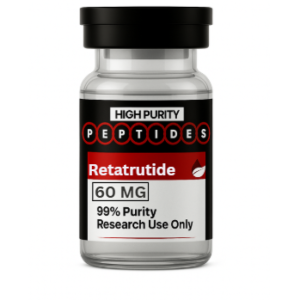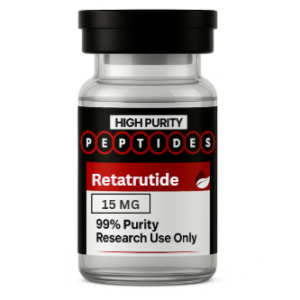Retatrutide 40mg × 10 vials
$280.00
Buy Retatrutide 40mg peptide × 10 vials for intensive metabolic research.
Product successfully added to the Quote List
Retatrutide Peptide Dosage Guide for Research Use
Retatrutide peptide, also known as LY3437943, is a synthetic triple receptor agonist that targets GLP-1, GIP, and glucagon receptors. Due to its multi-receptor engagement, Retatrutide has become a focus of interest in metabolic, endocrinological, and obesity-related research.
This guide explores the retatrutide peptide dosage ranges commonly used in preclinical and animal studies, how it is administered in a research setting, and considerations for preparing accurate solutions. Please note: retatrutide is not approved for human use and should only be used in accordance with appropriate laboratory safety guidelines.
What Is Retatrutide?
Retatrutide is a synthetic linear peptide designed to mimic the actions of three key metabolic hormones:
-
GLP-1 (Glucagon-Like Peptide-1): Enhances insulin secretion and appetite suppression
-
GIP (Gastric Inhibitory Polypeptide): Supports insulin release
-
Glucagon: Stimulates fat oxidation and energy expenditure
By combining these pathways, Retatrutide delivers a synergistic metabolic effect and is being explored in research on obesity, type 2 diabetes, and weight regulation.
Retatrutide Peptide Dosage in Research
While official dosing guidelines do not exist for research-only peptides, publicly available preclinical studies, including animal trials and early pharmacokinetic evaluations, have provided insight into research dosage ranges.
Typical Research Dosages (Animal Models):
| Study Type | Dosage Range (per kg) | Frequency |
|---|---|---|
| Rodent studies (mice, rats) | 0.01 mg/kg to 0.3 mg/kg | Once weekly or daily |
| Obesity/metabolic disorder models | 0.05 mg/kg to 0.2 mg/kg | Weekly subcutaneous (SC) |
| Pharmacokinetics (PK) studies | Up to 0.5 mg/kg | Single-dose or repeated |
These doses are based on subcutaneous (SC) administration. Intraperitoneal (IP) or intravenous (IV) administration may require adjustment.
Note: These values are reported in the context of animal research only. Retatrutide is not approved for human consumption and should not be used outside of controlled research environments.
Molecular Information for Solution Preparation
To ensure accuracy in dosing, it’s critical to understand the
of Retatrutide:
-
Molecular Weight: 4731.33 g/mol
-
Molecular Formula: C₂₂₁H₃₄₂N₄₆O₆₈
-
Recommended Concentration for Stock Solution: 1–2 mg/mL (in bacteriostatic water or sterile saline, depending on study design)
-
Reconstitution: Gently swirl to dissolve—do not shake vigorously
-
Storage After Reconstitution:Store at 4°C for short-term (1–2 weeks); aliquot and freeze for long-term use
Always filter sterilize if sterility is required for cell culture or in vivo models.
Administration Frequency
Retatrutide has demonstrated long half-life properties in preclinical data and early clinical-stage research, supporting once-weekly dosing in many studies. This makes it similar in frequency to other long-acting GLP-1 agonists such as semaglutide or tirzepatide, which have weekly or biweekly schedules in research trials.
Researchers studying glucose control, energy metabolism, or appetite regulation typically evaluate Retatrutide with weekly administration over several weeks to observe cumulative effects.
Research Applications of Retatrutide
Retatrutide’s triple-agonist mechanism opens the door to several promising areas of research:
-
Weight loss and appetite suppression mechanisms
-
Glycemic control in insulin-resistant animal models
-
Hormonal signaling and receptor crosstalk
-
Energy expenditure and thermogenesis pathways
-
Combination therapy studies involving GLP-1 analogs
Its unique structure allows for simultaneous engagement with multiple metabolic systems, offering a comprehensive research model.
Important Considerations
-
Retatrutide is for laboratory research only.
-
Dosage should be determined by the institutional review board (IRB) or IACUC protocols when used in animal research.
-
All handling should follow laboratory safety standards for peptides and synthetic biological agents.
-
Always verify purity and concentration from your supplier (look for >99% purity with HPLC/MS verification).
Final Thoughts on Retatrutide Peptide Dosage
Understanding the proper retatrutide peptide dosage is essential for generating accurate, reproducible results in scientific studies. While specific dosages depend on the model organism, study design, and administration route, most researchers follow standardized ranges based on prior literature and pharmacokinetic modeling.
If you’re sourcing Retatrutide for your research, make sure to select high-purity, lab-tested peptides and consult relevant data before establishing your own dosing protocol.
For Research Use Only
Retatrutide is not intended for human consumption or therapeutic use. All content provided here is for educational and informational purposes in the context of laboratory-based research.
Buy Retatrutide 40mg × 10 Vials Online
Highest dose of retatrutide for rigorous metabolic and endocrinology studies.







